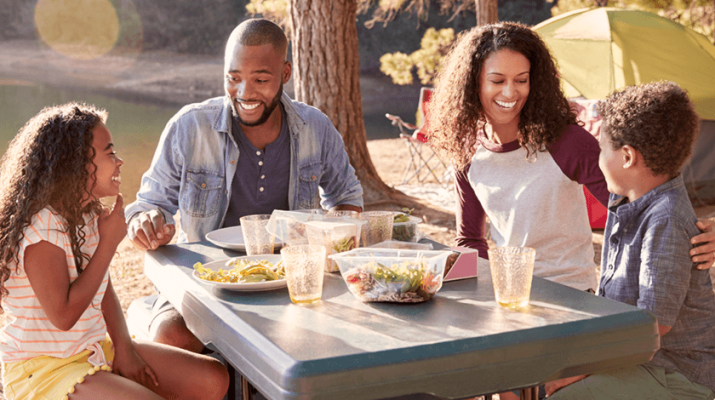Picnics and cookouts raise the risk of issues such as cross contamination and food-borne pathogens. Follow a few simple rules to avoid the problem
By Deborah Jeanne Sergeant
Now that it’s picnic season, why not brush up on food handling tips to ensure your food is safe?
Picnics and cookouts raise the risk of issues such as cross-contamination and food-borne pathogens because we’re cooking and handling food outside the routine environment of the kitchen.
“The biggest dangers in handling food for a picnic or cookout involves not properly preparing, serving and storing foods,” said Molly Rockford, registered dietitian nutritionist and clinical nutrition specialist at UR Medicine’s Wilmot Cancer Institute. “Cross-contamination, when bacteria from uncooked food is spread to cooked food, is one of the main ways we can get sick.”
For example, if you place cooked meat on the same platter that held it before it was cooked, the prepared food can become contaminated with bacteria. Or if you moved raw meat with the same set of tongs that you use for serving it. Or if you marinade raw meat and later use the marinade to baste the meat as it cooks, you spread bacteria all over it.
Rockford listed a few foods that can cause cross contamination, including raw steak, chicken, ground meat and seafood.
Rockford also said that cutting boards can promote cross contamination. Never use one for raw meat followed by food that’s not cooked, like fresh fruits and vegetables.
“Designate one cutting board for raw meats and one for raw fruits and vegetables,” she advised. “When preparing foods, wash cutting boards, utensils and work space with hot soapy water, between each food item. Keeping things clean and separate throughout the process of preparing and cooking foods can greatly reduce the chances of cross contamination.”
By preparing as much as you can at home, you can help prevent many cross-contamination issues.
Rockford also implicated food storage temperature as a cause of bacterial growth. When it comes to perishable foods, cold foods should be kept cold and hot foods should be kept hot.
“It is important to cook foods to the desired internal temperature, then keep these foods above 140 degrees,” she said.
The USDA advises using a meat thermometer in the thickest part of the meat to gauge temperature. Cook beef, pork, veal, fish, shellfish and lamb to 145 F, ground meats to 160 F, and all types of poultry to 165 F. Don’t rely on the meat’s color or if the juices run clear.
Don’t come back and grab a grilled chicken thigh long after the coals have cooled; eat cooked foods promptly after cooking.
As for cold foods, keep them below 40 degrees. While a delicious picnic spread out on the tables looks inviting, “items like pasta and potato salads, fresh fruit and vegetables should remain in coolers packed with ice until ready to serve,” Rockford said. “This will help ensure cold items stay below 40 degrees. Also, when serving cold food, place on ice and return to cooler after being out for two hours, if it’s hotter than 90 degrees, one hour.”
Heather Carrera, doctor of clinical nutrition at the integrative health practice of Dr. Lesley James in Pittsford, explained the “danger zone” of food temperature.
“Bacteria grow most rapidly in the range of temperatures between 40 “F and 140 F, doubling in number in as little as 20 minutes,” she said.
In addition to using a cooler for cold foods, keep foods heated at home in an insulated container. Carrera said that using an alarm on your cell phone can help remind you when it’s time to put food away.
What you serve can also make a difference.
“Relying too heavily on foods that spoil easily can be dangerous,” Carrera said. “Instead of using mayonnaise and eggs, try using salads that use fresh fruit, vegetables, and an oil and vinegar-based dressing instead. Monitor similar foods such as tuna salad, potato salad, or anything dairy-based closely.”
Begin with cold foods that are already cold. Don’t try to rely on the cooler to chill foods.
How you serve cold items can affect their temperature as well. For instance, keeping all the drinks with the cold salads in one cooler isn’t a great idea.
“Constantly opening a cooler to get drinks will lower the temperature drastically,” Carrera said. “Keep food in a separate cooler that is only opened when ready to prep foods. If the food cooler temperature increases past 40 degrees, it’s entering the danger zone.”
She recommends packing a cooler with a layer of ice at the bottom, followed by raw or marinating meat in sealed containers, followed by salads, slaws and condiments on top, which can prevent any meat drippings from leaking into ready-to-eat foods.
It can also help to fill coolers up to the brim. Use up any empty space with things like napkins and plates or snacks that don’t need refrigeration.
Avoid repurposing ice.
“Don’t use loose ice used to keep food cold as ice for beverages,” Carrera said. “This ice could have picked up bacteria from leaking food.”
Bringing along a melon to slice? Don’t forget to wash it first; otherwise, every cut of the knife draws bacteria inside, to the flesh. Cut it on a clean surface.
Carrera also advises washing up after handling raw meat, using warm soapy water.
“Bring hand sanitizer if you’re at a picnic without running water,” Carrera said.

